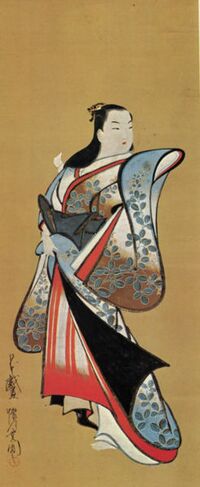Kaigetsudo Ando

Kaigetsudô Ando, also known as Ando Yasunori, was the founder of the Kaigetsudô school of ukiyo-e painting. Though very influential and prolific, it is quite probable that many of the works attributed to him were actually painted by his disciples. He is something of a rarity among major ukiyo-e artists, in that he was only ever a painter, and never produced woodblock prints.
Ando lived in the Suwa-chô district of Asakusa, in Edo, very near the Sensô-ji, and on a major road which led to the Yoshiwara, roughly a mile north of the city. Principally active from 1700-1714, it has been surmised by some scholars that his early training may have been in ema, wooden votive tablets sold at Shintô shrines. One of the distinctive elements of his style is the sense of emptiness around his figures, an element which fits well with the medium of the ema; this theory is supported by the idea of his location on the main road, where a great number of pilgrims and travelers would have passed daily.
Some scholars dismiss this theory, but it is nevertheless evident that Ando was closely connected to the trends of popular culture, art, and literature at the time. His style shows influences of the father of ukiyo-e painting, Hishikawa Moronobu, and his disciples, as well as influences from book illustrators such as Yoshida Hanbei.
Ando's particular focus was on the bijinga (images of beautiful women), and in his time he and his studio nearly monopolized the production of images of the courtesans of the Yoshiwara, Edo's pleasure district. His style is especially distinguished by the elaborate, and often brilliantly colorful, patterns on the courtesan's kimono. These were truly images of the latest fashions, or perhaps of the artist's own fashion ideas, just as much as they were images of the women. It has also been said that his women had an austerity and aloofness that placed them above pure representations of sexuality, the Edo period equivalent of "pin-ups".
As the founder of a school, it should come as no surprise that his style was fresh, new and innovative, and quite distinctive. This style would be continued by his direct disciples (some of whom were his sons or other direct relations), often so closely that paintings done by them have come to be misattributed to Ando.
Kaigetsudô Ando's career came to an end in 1714, with the so-called "Ejima-Ikushima Affair." It is not entirely clear how he was involved in this scandal which revolved around a high ranking court lady and a kabuki actor (who held a very low status in society, along with all actors and entertainers). All those involved were banished from Edo.
He left five direct pupils who carried on the school after Ando's banishment and retirement from the art world: Kaigetsudô Anchi, Doshû, Doshu, Dohan, and Doshin.
Reference
This article was written by User:LordAmeth and contributed to both the Samurai Archives Wiki and Wikipedia; the author gives permission for his work to be used in this way.
- Lane, Richard (1978). "Images of the Floating World." Old Saybrook, CT: Konecky & Konecky. pp68-71.